Masters of Doom is a Masterful Book

I was still in elementary school when I was first exposed to Doom. It was through no ingenuity or knowledge of my own that I came to witness it, but that of my high-school aged older brother. I had descended down the basement where our not-so-great computer was kept, my father believing such a machine need only be powerful enough to run Microsoft Office (a philosophy he maintains to this day). I don’t know which of his friends my brother had gotten the floppy disk from, or if he had found it on his own somehow else, but he had installed the game and been playing it that afternoon. Upon seeing me walk down the steps, around our father’s drum set and towards the cold corner in which the computer was kept in our unfurnished basement, he had reset the title so that I could give it a try from the beginning.
Of course, he then hurried upstairs, grinning that smarmy grin of his as he left me by my lonesome. I decided to start the game up, already disturbed somewhat by the Hellish imagery that would look cartoonish and absurd by modern standards. I don’t know if it was due to the lack of such state-of-the-art technology as a CD-ROM or some other crucial piece of missing hardware – were there even sound cards back then? – but none of the game’s headbanging thrash MIDI played. Instead, the Mars base was completely silent save for the cackling of demons in the next room, hurling fireballs in my direction.
Rather than being pumped up and ready to deliver hot lead into soft demon tissue, I got frightened, shut the game down, and sprinted out of our already creepy basement and up to my brother. I recall he was surprised to see me upstairs so quickly, but he was also amused that I got so unnerved by it. It was as if he had predicted my terrified response, which is why he was so glad to leave me down there alone in the first place.
I had no idea this creepy game was about to become one of the biggest PC releases ever, nor that it was giving birth to a whole new genre, or that its developers, John Carmack and John Romero, were changing the nature of game development forever. Now, almost twenty years since the book was published, I’ve been given a fresh and impressive new perspective from Masters of Doom.
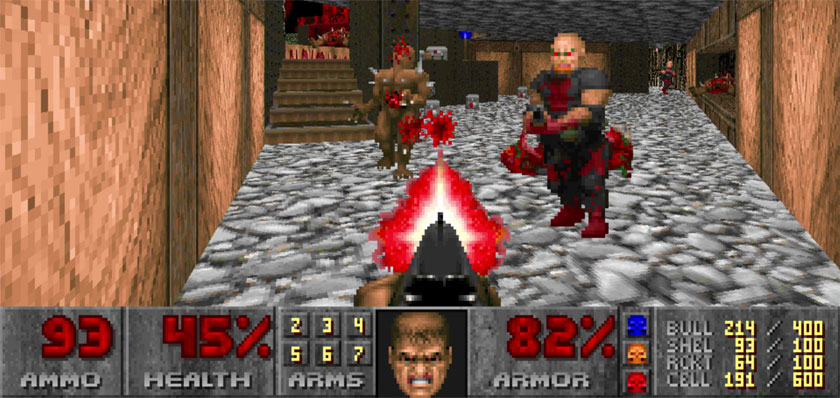
I’ve got a soft spot for stories where “a group of guys get together and create something”. The first to make a long-lasting impact on me was October Sky, a film based on Homer Hickam Jr.‘s The Rocket Boys memoir. It followed his time in high school struggling to develop a rocket of his own in the small coal town of Coalwood, the hard work and determination of he and his friends causing them to beat the odds, overcome their obstacles, and successfully build a scholarship-winning rocket. While I had no head for science myself, I found Homer’s conflict with his father relatable and the story inspirational. Each viewing left me with a jittery desire to just make something.
The next several years would slowly see a trickle of documentaries and dramatized biopics creep into my attention, each a fascinating look at the creative process and how its pioneers would change the world. First would come G4’s Icons television show, one of the only bits of worthwhile programming on the channel until it began to cover celebrities unrelated to the industry (such as over-priced-clothing designer Marc Ecko). In College I would discover Pirates of the Silicon Valley, a made-for-TV movie chronicling the founding, success, troubles, and often unethical behavior of Apple and Microsoft. Following College and entering adulthood I would find The Social Network to use the founding of Facebook as a fascinating examination of how young men define success and what – or even who – they’ll sacrifice to achieve it. Straight Outta Compton wasn’t just about the founding of West Coast rap group N.W.A., it was also exploring the collision of artistry, business, and gang life. Online I had become enthralled by many of Noclip’s early documentaries, only to be followed up by the Gameumentary feature on the Darksiders franchise, Sony’s promotional making-of feature for 2018’s God of War, Raising Kratos, and, most recently, Power On, the 20th anniversary making-of documentary of the Xbox.
Masters of Doom is the first time a book has delivered on all of the above and more. It is filled with a unique perspective of games history, from growing up playing the first arcade machines to the industry-wide crash; from the surprise hit of the Nintendo Entertainment System in America to the evolution of the PC as a gaming platform. It has a group of guys all coming together to make something special and world changing. It has oversized egos and eccentric personalities clashing in dramatic conflicts that culminate in impenetrable rifts between friends.
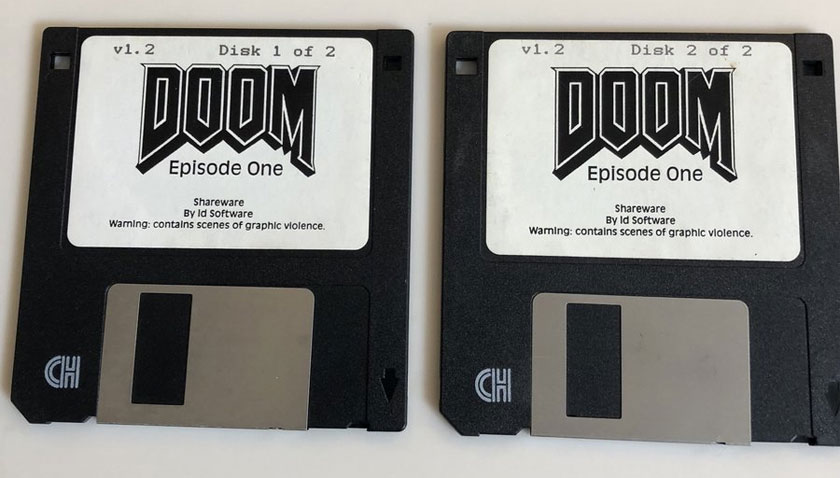
The one thing it seems to possess, however, that many of the above films or even documentaries seem to lack is humble honesty. Many of the films above were either modified to be more palatable to general movie-going audiences – revising just enough history to make events look at least a bit more squeaky clean than they were in real life or far more dramatic than they actually had been – or would inevitably become somewhat of a marketing piece; even if mistakes or the dark sides of development were acknowledged and portrayed, the end result is often pure success.
Or, in the case of The Social Network, a flawed young man is portrayed to seem even more despicable than he likely was in reality, all because doing so made for a better movie.
Masters of Doom is a different experience, however, and likely because its nature as a book allows it to tell a more complete story without the need to remove details or modify them to fit a specific time limit. Author David Kushner is able to delve into the many aspects of Johns Romero and Carmack, exploring their positive traits as well as the negative to tell a story not of how wonderful or deplorable these men are. Instead, it’s more a tale of how youth and vigor can become the greatest obstacle to success once it has been achieved, how inflated egos can lead to one’s downfall, how the changing tide of technology can complicate that which was once simple, and the harsh conditions in which we human beings must sometimes be forced to endure so that we might learn. It is also a story that could only have occurred at this specific place in time.
To rewind back to the beginning, however, I first find Masters of Doom fascinating as it brings a portion of gaming history I did not experience under a microscope. I have a lot of general knowledge regarding the console games business, but the evolution of PC games alongside the likes of Nintendo, SEGA, and Sony’s PlayStation is more of a vague mystery. This is, in part, due to PC games having no unified history at that stage. Between Apple computers, the Commodore 64, and Microsoft DOS and Windows growing as gaming platforms, the medium was evolving and changing on the PC in a variety of different directions.
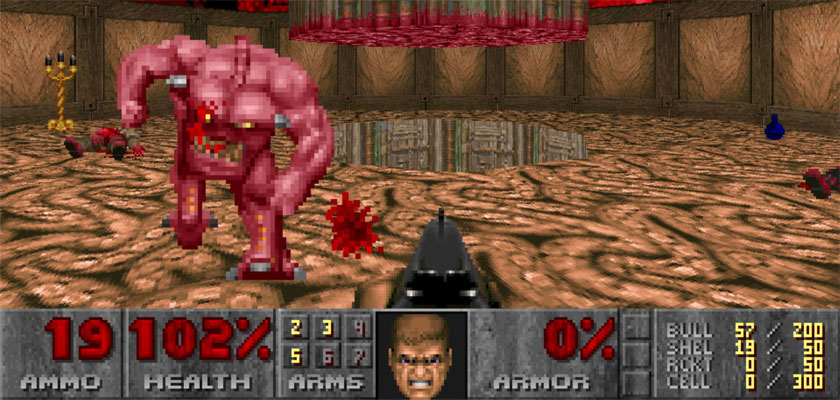
All my life I had been told that PCs were more powerful and therefore better for gaming than consoles, so it was a shock to discover that one of the reasons Super Mario Bros. 3 was so amazing to the likes of Romero and Carmack was due to the computer’s inability to render the side-scrolling map like the NES could. The machines were, evidently, too slow to handle such processing power; that is, until John Carmack was able to figure out a series of work-arounds to cause the game to more selectively render the pixels on-screen. When I read the layman’s explanation of what Carmack had achieved, I was taken back to a freshman class in College in which I was informed of how video is digitally encoded for playback or streaming. John had accomplished something similar, only far ahead of the digital age in which such compression and rendering would become commonplace.
The notion that PC’s were more powerful than consoles was not always true, and that’s all the more reason to be in awe of everything Carmack had accomplished before graphics cards were a thing. I always knew that he was a genius programmer, but more through his reputation than exact knowledge of his work. With Masters of Doom helping to provide context, it’s easy to see why id was managing to stun and surprise so many players throughout the world.
Of course, Carmack’s genius would also be his own undoing, as games were the vehicle for his exploration into graphics rendering and creating virtual worlds. With the context provided by this novel, it is no surprise that the man would leave id to one day join the Oculus team in creating a device capable of bringing humanity one step closer to the Holodeck of Star Trek: The Next Generation. This interest in worlds and engines would ultimately set him apart from the other team members at id, who each were, in some way, more inclined towards the creative aspect of building a fun game.
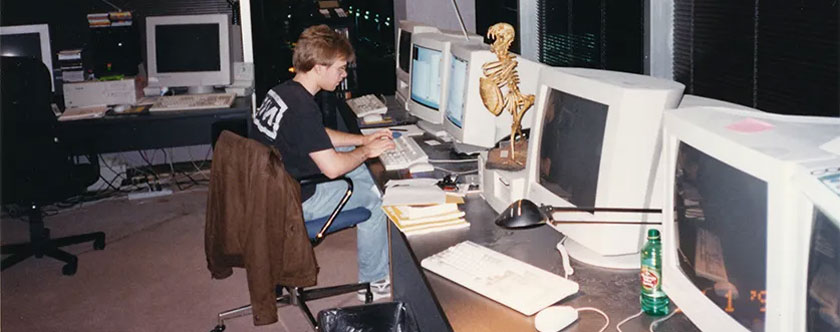
The greatest of those separations would naturally be John Romero, who had, at one point, complemented the programmer greatly. If this book were to have a “protagonist”, I would argue that it is Romero and Carmack is his foil. This is not to the book’s intention, of course, but even in text it is far too easy to get caught up in the long-haired gaming rock star’s enthusiasm and childlike glee.
It is also what makes the book somewhat sad to read. With nearly thirty years of industry hindsight, capable of identifying many of the wrong turns big publishers and developers have taken in the wake of the ever-changing technology on offer, it’s too easy to point to specific decisions and actions that caused everything to turn sideways for id Software. The desire to expand the games without expanding the team, for starters, while simultaneously just expecting everything to come together and work out as it always has. It is the hubris of youth, though one earned and awarded due to the hard work the young men had already achieved up to that point.
By the book’s conclusion, John Romero has far more than just egg on his face. He was high on his own supply of hype, but it wouldn’t have all come crashing down if games weren’t immediately evolving after the release of Doom. Carmack himself was ready to usher in a new age of three-dimensional polygons and rendering, and shortly after came the advent of graphics cards to push personal computers beyond what console games were capable of achieving. It didn’t help that Romero’s interest in making games was driven by his love of playing them, and therefore causing him to divide his time between work, play, and reaching out to the fans… with whom he would also play.
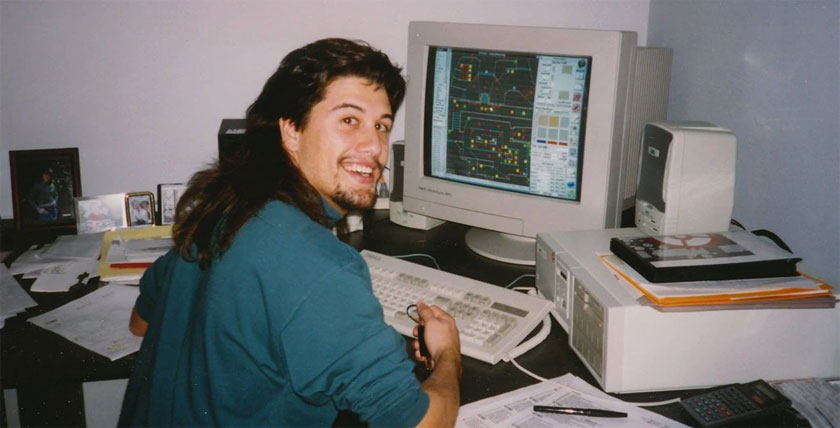
It’s a shame, because the obvious decision would be for John Carmack to lead a technical development group focused on pushing id’s engines forward while John Romero led the teams building games with old and new tech. As stated, hindsight is always 20/20, and the reason they hadn’t made such a decision is because they were still in their own professional infancy, not just the industry as a whole. Additionally, while it sounds good on paper, Romero was so incapable of self-restraint that he would inevitably fail to create a product capable of delivering regardless. It was just a matter of when.
So, instead, Romero clashed with Carmack because they both had different ideas as to what game development – and what being a game company – meant. Where John Carmack continued to lead id and find success, however, it was John Romero that would be forced to strike out on his own and face his own failures.
Masters of Doom left me with a lot of questions. After all, it’s been almost twenty years since the book was first published and a lot has happened in that time. Doom 3 released, showcasing John Carmack’s impressive implementation of lighting technology only to be met with criticism once players got their hands on it. Oh, the game was certainly good, but I imagine it quickly became clear that Romero’s touch – and no doubt the touch of many of the id employees left miserable or disgruntled by book’s end – was missing, even if only in hindsight. One can even theorize that the tepid-to-negative response to RAGE would indicate to Carmack that perhaps it was time to leave, hopping on over to Virtual Reality to meddle in the ability to render worlds rather than fuss about with gameplay and the like. Meanwhile, Romero’s reputation had become completely tarnished with Daikatana, and while the man didn’t disappear from the limelight completely, he certainly hasn’t been able to reclaim his status as industry icon since the 90’s. Even so, he’s at least enjoying some degree of success with his studio, who released the prohibition-era strategy game Empire of Sin last year.
It is a mere shadow of the once dominant presence of both men in the industry. Carmack is only tangentially related through Virtual Reality, and Romero continues to produce games, only they slide under the radar of most players. They are present, but they are also phantoms.
Even so, I must say I was glad to read Masters of Doom, and will no doubt go back and read it again one day. Anyone that grew up in the 90’s – and especially those with a passion for the medium – really ought to give this book a look. It’s filled with interesting tidbits about the industry, the evolution of technology throughout the decade, and the dangers of success to young men not yet ready to handle such a fragile prize. An inspiration, a cautionary tale, and an opportunity to better humanize and understand two of gaming’s greatest legends.


